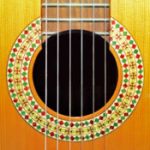How to run a creative workshop based on Woman Playing a Clavichord
Artwork by Gerrit Dou , created in 1665
About this activity
Workshop themes
- Carpentry
- Medieval
- Musical instruments
- Rhythm
- World music
Suitability
- Suitable for groups
- Suitable for one to one
Difficulty level
Easy

Skip to section
Introductions
Materials
- Name badges (for all participants and staff).
Method
- Go around the room and make eye contact with everyone, shake their hand and say hello.
- Sit in a circle. As the facilitator, let the group know that you are going to pass a clap around the room. Turn to the person next to you (clockwise) and clap your hands once in their direction. The next person then does the same and it continues around the room until the clap has gone around the whole circle.
- This could be extended by sending the clap in the opposite direction, speeding it up, or missing alternate people out. What will work best will depend on the needs and abilities of the group. As the facilitator, you will know what will work best.
- This warm-up will start people thinking about sound, rhythm and music.
TimeSlips™
Materials
- Flipchat and pen
- An image of the artwork (can be viewed in the app or printed from this link )
Method
- Look at the artwork using the Armchair Gallery app.
- Welcome and invite the person or group to create with you and write their answers on the flip chart. Ask open-ended questions (like in the list to the right).
- Affirm/echo all their answers - together we build a story that can have sound, movement, words - even drawings.
- Retell the story, then invite them to add another creative element like sound, or movement.
Suggested Questions
- What is going on in this painting?
- Where is she?
- What is she playing?
- How does this painting make you feel?
- If you were there, what sound/s can you hear?
- What type of music does this artwork make you think of? (classical, opera etc.)
- What is she looking at?
- When do you think this artwork was created?
- What could her name be?
Play this video
Workshop members can watch this on their own tablet, or you can play it to the group by connecting your tablet to a TV or projector. It can also be downloaded from the Armchair Gallery website.
Interact with the artwork
At this point in the workshop participants should have a go at using the app to interact with the artwork. From the main menu, enter Dulwich Picture Gallery, select Woman Playing a Clavichord and tap Interact and play.
Multi-Sensory Exploration, Part 1
Materials
- Wifi will be needed to download music or create a playlist.
- Speakers for music.
- Various musical instruments such as maracas, shakers, tambourines etc.
- Boomwhackers, a selection of sizes and colours.
- Fabrics, varying in textures, such as chiffon, silk and velvet.
- Other multi-sensory objects could include horsehair, violin bows, keyboards and accordions.
- Sawdust or wood chippings.
- Fresh warm bread and non-alcoholic wine.
Sound
- Create a music quiz (play different pieces of music) and participants, which type of dancing comes to mind when you hear specific pieces of music? i.e. Tango, Waltz etc.
- A music quiz playlist can be created on both YouTube and Spotify. All music is readily available to listen to without purchasing it (see the extra resources to find out how to make a playlist).
- Create simple choreographed seated movements. Slowly go through each step and build up, repeating the steps so the entire group feels confident.
- Movements could include tapping hands on knees; tapping toes on the floor; arm circling and swaying using the arms.
- Go through the movements with your group a few times until everyone is happy with them before you add music.
- Extend these movements by asking individuals in the group to think of a movement and ask the rest of the group to follow using a method called call and response.
- You could ask your group to choose a piece of music or alternatively, you could opt for this clavichord piece of music.
clavichord piece of music.
- Use a selection of different boomwhackers and instruments to explore rhythm. Each boomwhacker has a different tonal sound with immediate effect. The boomwhacker only needs to be touched lightly to create a sound. Therefore individuals who struggle with movement can participate.
- As the facilitator, let the group know that you are going to begin tapping out a rhythm together and ask them to join in. Continue that rhythm until the group feel comfortable. Then ask half of the group to start a new rhythm. Experiment and see how the group responds to different rhythms.
Multi-Sensory Exploration, Part 2
Taste
- Inspired by medieval meals and tastes, hand around some fresh warm bread and serve with non-alcoholic red wine.
Touch
- Pass around a stringed instrument and ask each member of your group to pluck a string and to feel the vibrations.
- Pass around and explore horse hair, violin bows, keyboards, and accordions (and any other musical instrument that you are able to use). When passing the instruments to the group, questions could be asked such as: What have you got there? What does that make you think of? Have you seen anything like that before?
- This could be an extension to your TimeSlips activity, swopping the use of objects for words in response to the artwork, prompting stories and interaction.
Multi-Sensory Exploration, Part 3
Sight
- Any heavy fabrics such as embroidered carpetbags or curtains would work well to touch and look at.
Smell
- Pass around a bag full of wood chippings or sawdust to smell. This will evoke the smell of the instruments and the damp, fusty room that the Woman Playing a Clavichord, is painted in.
Making: Drum Instrument
Making: Drum Instrument
This activity gives participants a good opportunity to explore rhythm and sound by making their own mini drum. Once made, their drum could be brought into other planned sessions as a musical instrument, either to explore further as a group or as an individual.
Materials
- Drum Base, plastic bowls, buckets or tupperware.
- Circular balloons, an assortment of sizes and colours.
- Heavy duty duct tape.
- Scissors.
- Tools to play instruments with such as pencils, chopsticks or hands.
- Sharpies/ribbons or any additional arts materials for decorating the balloon drum.
- iPad or recording device to capture the group drumming with their hand-made mini drums.
Method
- Collect a variety of containers. Small glass ramekins are the perfect size for using normal sized balloons.
- Cut the neck off the balloon using scissors, leaving the large part of the balloon to form the drum.
- Stretch the balloon over the container and secure the edges down with brown tape.
- Add decorations to your mini drums. Washi tape can be used to disguise the brown tape, lace, sequins and sharpie pen decorations too.
- Continue to make the drums until you have a selection ready to play. They can be played with wooden sticks, chopsticks or pencils. If they vary in size and shape, they will play various sounds.
- These drums could be used within another workshop or you could re-use them in the multi-sensory (sound element) of this workshop.
Celebration
Celebrate your session by recording your group playing rhythms on their drums and re-play this to your group. Conclude the session with a big round of applause and thank everyone for attending and contributing.
Finally…
Getting Materials
You should be able to get most of the materials mentioned in this guide at your local arts supplier.
They are also avaiable on Amazon. If you shop via Amazon Smile (using the button below - UK only), then we will recieve a donation that we can put towards our work with older people.
Other Apps
You could use these other apps to further explore digital technology in your workshop.



